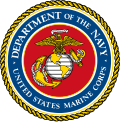Higher headquarters
II MEF falls under the command of U.S. Marine Corps Forces Command (MARFORCOM), and is a service retained force, meaning it is not assigned or allocated to any of the Geographic Combatant Commands. However, II MEF regularly provides subordinate units in support of operations and exercises throughout the U.S. European Command, U.S. Africa Command, and U.S. Southern Command Areas of Responsibility, as well as in support of other U.S. unified and NATO commands. II MEF units are available for and prepared to respond to contingency requirements worldwide. [1]
Employment
In addition to the option of being employed in its entirety as a MEF-sized unit, II MEF has the capability of forming task-organized Marine Air-Ground Task Forces (MAGTF) of lesser size such as a MEF (Forward), a brigade-sized MAGTF (Marine Expeditionary Brigade or "MEB") about one-third the size of a MEF or a Marine Expeditionary Unit (MEU), about one-third the size of a MEB. The size and composition of any MAGTF will be dependent upon the mission assigned. One mission that could be assigned to the MEB would be assignment for planning, deployment and utilization of equipment stored aboard Maritime Prepositioning Ships (MPS). The MPS program involves the forward deployment of the MPS Squadron of four or five ships loaded with a brigade's worth of combat equipment and supplies and the airlifting of the MEB to the designated objective area to link up with the MPS Squadron. At the same time, tactical aircraft of the MEB are flight ferried to an airfield in or near the area of operation. The MEB can be sustained for 30 days by the supplies aboard the ships.
The only routinely deployed MAGTFs, the 22d, 24th and 26th MEUs deploy on a rotating basis to the Mediterranean Sea area to serve as the landing force for the Commander, 6th Fleet. The MEU consists of approximately 2,200 Marines and Sailors, is capable of rapid response in a variety of possible contingencies, and if the situation requires, can serve as the forward element of a larger MAGTF. [2]
This page is based on this
Wikipedia article Text is available under the
CC BY-SA 4.0 license; additional terms may apply.
Images, videos and audio are available under their respective licenses.



















